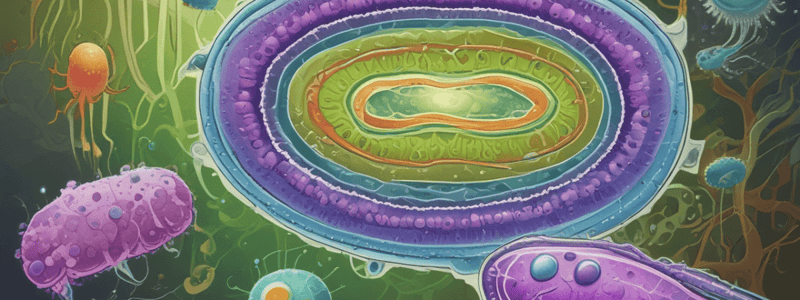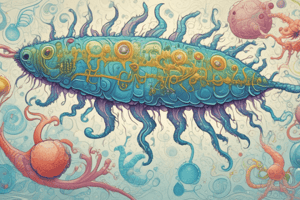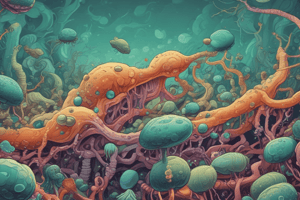Podcast
Questions and Answers
Protists represent a significant portion of diversity in prokaryotic microorganisms.
Protists represent a significant portion of diversity in prokaryotic microorganisms.
False (B)
Which organelle is responsible for protein synthesis in eukaryotic cells?
Which organelle is responsible for protein synthesis in eukaryotic cells?
- Endoplasmic Reticulum (ER) (correct)
- Nucleus
- Golgi Apparatus
- Mitochondria
Protists are mostly unicellular life forms.
Protists are mostly unicellular life forms.
True (A)
Match the following protists with their characteristics:
Match the following protists with their characteristics:
What are the features of Cryptosporidium oocysts?
What are the features of Cryptosporidium oocysts?
Which parasite is responsible for causing Toxoplasmosis?
Which parasite is responsible for causing Toxoplasmosis?
Toxoplasma infected mice lose their fear of cats.
Toxoplasma infected mice lose their fear of cats.
Malaria is caused by 4 species of __________.
Malaria is caused by 4 species of __________.
Match the following parasite with its respective disease:
Match the following parasite with its respective disease:
Which domain do protists belong to?
Which domain do protists belong to?
Are some protists human and plant pathogens?
Are some protists human and plant pathogens?
What is the main feature of Oocysts of Cryptosporidium related to their size and resistance?
What is the main feature of Oocysts of Cryptosporidium related to their size and resistance?
How many Oocysts of Cryptosporidium are required to cause an infection?
How many Oocysts of Cryptosporidium are required to cause an infection?
Toxoplasma infected mice lose their fear of cats, which benefits both the cat and the parasite.
Toxoplasma infected mice lose their fear of cats, which benefits both the cat and the parasite.
Malaria is caused by 4 species of ________.
Malaria is caused by 4 species of ________.
Match the malaria parasite developmental stage to its location:
Match the malaria parasite developmental stage to its location:
What are some common features of Eukaryotic cells?
What are some common features of Eukaryotic cells?
Match the following organisms with their descriptions:
Match the following organisms with their descriptions:
Giardia is a human pathogen that primarily affects the respiratory system.
Giardia is a human pathogen that primarily affects the respiratory system.
Which parasite infects mice and causes them to lose their fear of cats?
Which parasite infects mice and causes them to lose their fear of cats?
Toxoplasma infected mice experience permanent long-term behavior change.
Toxoplasma infected mice experience permanent long-term behavior change.
Malaria is caused by species of ____________.
Malaria is caused by species of ____________.
Match the features with their corresponding parasite:
Match the features with their corresponding parasite:
Protists are mostly unicellular organisms.
Protists are mostly unicellular organisms.
Match the following protists with their descriptions:
Match the following protists with their descriptions:
Flashcards are hidden until you start studying
Study Notes
Eukaryotic Microorganisms
- Bacteria and protists are prominent members of ecosystems, model systems, and industrial applications.
- Protists represent a majority of the diversity in the Eukarya domain, and some are human and plant pathogens.
Common Features of Eukaryotic Cells
- Eukaryotic cells have sexual and asexual reproduction, meiosis, and mitosis.
- They have a membrane-bound nucleus, plasma membranes (lipid bilayers), and membrane-enclosed organelles.
- Many have cell walls, and their organelles include endoplasmic reticulum (ER), Golgi apparatus, mitochondria, and ribosomes.
Protists
- Protists are a general term for eukaryotic microorganisms that don't fit into any other kingdom-level group.
- They are mostly unicellular, with over 60,000 different life forms, including algae, slime molds, and protozoa.
- Protists are important links in food chains and are found in aquatic habitats, such as plankton, radiolarians, diatoms, and foraminiferans.
Chlamydomonas
- Chlamydomonas is a unicellular green alga with a cell wall made of cellulose.
- It has oxygenic photosynthesis, is motile via two flagella, and has a stigma (eyespot) for phototaxis.
Dictyostelium
- Dictyostelium is a cellular slime mold with two types of nuclei: micronucleus and macronucleus.
- It has a life cycle that involves free-living amoeboid cells, aggregation, formation of a motile slug, and eventually, a fruiting body with spores.
Giardia
- Giardia is a protozoan parasite that causes giardiasis, a human disease.
- It has a life cycle that involves cysts, trophozoites, and attachment to the intestine, leading to severe diarrhea and fluid loss.
Naegleria fowleri
- Naegleria fowleri is a free-living, aquatic amoeba that causes primary amebic meningoencephalitis (PAM).
- It is a thermophile that can cause brain swelling and death.
Alveolata
- The Alveolata group includes protists with an apical complex, such as dinoflagellates, apicomplexans, and ciliates.
- Dinoflagellates have two flagella in grooves, are toxic, and cause "red tides."
Cryptosporidiosis
- Cryptosporidiosis is a human disease caused by Cryptosporidium, an apicomplexan parasite.
- Oocysts are transmitted in contaminated water, and the disease is a common cause of waterborne illness.
Toxoplasmosis
- Toxoplasmosis is a human disease caused by Toxoplasma, an apicomplexan parasite.
- Oocysts are found in raw or undercooked meat, and cat feces, and can infect mice and humans.
Malaria
- Malaria is caused by four species of Plasmodium, an apicomplexan parasite.
- It is transmitted by the bite of an infected female Anopheles mosquito and causes severe disease worldwide.
Control, Prevention, and Treatment
- Malaria control involves mosquito control, wetland drainage, insecticides, and netting.
- Drugs include chloroquine, which blocks the parasite's ability to degrade hemoglobin, and Malarone, which blocks e- transport and pyridine synthesis.
Eukaryotic Microorganisms
- Bacteria and protists are prominent members of ecosystems, model systems, and industrial applications.
- Protists represent a majority of the diversity in the Eukarya domain, and some are human and plant pathogens.
Common Features of Eukaryotic Cells
- Eukaryotic cells have sexual and asexual reproduction, meiosis, and mitosis.
- They have a membrane-bound nucleus, plasma membranes (lipid bilayers), and membrane-enclosed organelles.
- Many have cell walls, and their organelles include endoplasmic reticulum (ER), Golgi apparatus, mitochondria, and ribosomes.
Protists
- Protists are a general term for eukaryotic microorganisms that don't fit into any other kingdom-level group.
- They are mostly unicellular, with over 60,000 different life forms, including algae, slime molds, and protozoa.
- Protists are important links in food chains and are found in aquatic habitats, such as plankton, radiolarians, diatoms, and foraminiferans.
Chlamydomonas
- Chlamydomonas is a unicellular green alga with a cell wall made of cellulose.
- It has oxygenic photosynthesis, is motile via two flagella, and has a stigma (eyespot) for phototaxis.
Dictyostelium
- Dictyostelium is a cellular slime mold with two types of nuclei: micronucleus and macronucleus.
- It has a life cycle that involves free-living amoeboid cells, aggregation, formation of a motile slug, and eventually, a fruiting body with spores.
Giardia
- Giardia is a protozoan parasite that causes giardiasis, a human disease.
- It has a life cycle that involves cysts, trophozoites, and attachment to the intestine, leading to severe diarrhea and fluid loss.
Naegleria fowleri
- Naegleria fowleri is a free-living, aquatic amoeba that causes primary amebic meningoencephalitis (PAM).
- It is a thermophile that can cause brain swelling and death.
Alveolata
- The Alveolata group includes protists with an apical complex, such as dinoflagellates, apicomplexans, and ciliates.
- Dinoflagellates have two flagella in grooves, are toxic, and cause "red tides."
Cryptosporidiosis
- Cryptosporidiosis is a human disease caused by Cryptosporidium, an apicomplexan parasite.
- Oocysts are transmitted in contaminated water, and the disease is a common cause of waterborne illness.
Toxoplasmosis
- Toxoplasmosis is a human disease caused by Toxoplasma, an apicomplexan parasite.
- Oocysts are found in raw or undercooked meat, and cat feces, and can infect mice and humans.
Malaria
- Malaria is caused by four species of Plasmodium, an apicomplexan parasite.
- It is transmitted by the bite of an infected female Anopheles mosquito and causes severe disease worldwide.
Control, Prevention, and Treatment
- Malaria control involves mosquito control, wetland drainage, insecticides, and netting.
- Drugs include chloroquine, which blocks the parasite's ability to degrade hemoglobin, and Malarone, which blocks e- transport and pyridine synthesis.
Eukaryotic Microorganisms
- Bacteria and protists are prominent members of ecosystems, model systems, and industrial applications.
- Protists represent a majority of the diversity in the Eukarya domain, and some are human and plant pathogens.
Common Features of Eukaryotic Cells
- Eukaryotic cells have sexual and asexual reproduction, meiosis, and mitosis.
- They have a membrane-bound nucleus, plasma membranes (lipid bilayers), and membrane-enclosed organelles.
- Many have cell walls, and their organelles include endoplasmic reticulum (ER), Golgi apparatus, mitochondria, and ribosomes.
Protists
- Protists are a general term for eukaryotic microorganisms that don't fit into any other kingdom-level group.
- They are mostly unicellular, with over 60,000 different life forms, including algae, slime molds, and protozoa.
- Protists are important links in food chains and are found in aquatic habitats, such as plankton, radiolarians, diatoms, and foraminiferans.
Chlamydomonas
- Chlamydomonas is a unicellular green alga with a cell wall made of cellulose.
- It has oxygenic photosynthesis, is motile via two flagella, and has a stigma (eyespot) for phototaxis.
Dictyostelium
- Dictyostelium is a cellular slime mold with two types of nuclei: micronucleus and macronucleus.
- It has a life cycle that involves free-living amoeboid cells, aggregation, formation of a motile slug, and eventually, a fruiting body with spores.
Giardia
- Giardia is a protozoan parasite that causes giardiasis, a human disease.
- It has a life cycle that involves cysts, trophozoites, and attachment to the intestine, leading to severe diarrhea and fluid loss.
Naegleria fowleri
- Naegleria fowleri is a free-living, aquatic amoeba that causes primary amebic meningoencephalitis (PAM).
- It is a thermophile that can cause brain swelling and death.
Alveolata
- The Alveolata group includes protists with an apical complex, such as dinoflagellates, apicomplexans, and ciliates.
- Dinoflagellates have two flagella in grooves, are toxic, and cause "red tides."
Cryptosporidiosis
- Cryptosporidiosis is a human disease caused by Cryptosporidium, an apicomplexan parasite.
- Oocysts are transmitted in contaminated water, and the disease is a common cause of waterborne illness.
Toxoplasmosis
- Toxoplasmosis is a human disease caused by Toxoplasma, an apicomplexan parasite.
- Oocysts are found in raw or undercooked meat, and cat feces, and can infect mice and humans.
Malaria
- Malaria is caused by four species of Plasmodium, an apicomplexan parasite.
- It is transmitted by the bite of an infected female Anopheles mosquito and causes severe disease worldwide.
Control, Prevention, and Treatment
- Malaria control involves mosquito control, wetland drainage, insecticides, and netting.
- Drugs include chloroquine, which blocks the parasite's ability to degrade hemoglobin, and Malarone, which blocks e- transport and pyridine synthesis.
Studying That Suits You
Use AI to generate personalized quizzes and flashcards to suit your learning preferences.




